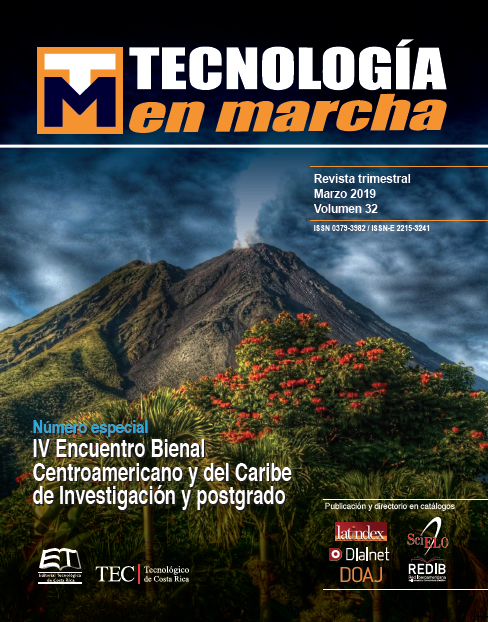The potential of augmented reality in the management of restoration of heritage buildings
Main Article Content
Abstract
In this document, some theoretical functions are exemplified that the technology known as Augmented Reality (AR) offers to the different users that are part of the built heritage management processes. In this specific case, the first topic that is addressed is the administration of patrimonial restoration projects, followed by the potential of the AR to be used as a support tool in these processes.
This is part of the Amón_RA research project: implementation of augmented reality in the enhancement of the historical urban heritage of the Amón neighborhood, registered with the Vice-Rector for Research and Extension of the Technological Institute of Costa Rica and coordinated by Dr. Arq David Porras Alfaro; as well as the proposal for the Final Project of Graduation to opt for the academic degree of Master in Project Management with Emphasis in Construction Projects entitled: “Professional management model of intervention projects of buildings with heritage declaration in Costa Rica . Case study: intervention plan of the Chapel of the Old Casa González Feo.”
In this project proposal the AR is addressed as a possible support tool for the execution of the aforementioned restoration plan of the property, which has a patrimonial declaration and is located on nine street and between avenues seven and nine in the Amón neighborhood, San José. In addition, part of the experience of the executed processes of the Amón_RA project during the year 2017 and the first semester of the year 2018.
Article Details
Los autores conservan los derechos de autor y ceden a la revista el derecho de la primera publicación y pueda editarlo, reproducirlo, distribuirlo, exhibirlo y comunicarlo en el país y en el extranjero mediante medios impresos y electrónicos. Asimismo, asumen el compromiso sobre cualquier litigio o reclamación relacionada con derechos de propiedad intelectual, exonerando de responsabilidad a la Editorial Tecnológica de Costa Rica. Además, se establece que los autores pueden realizar otros acuerdos contractuales independientes y adicionales para la distribución no exclusiva de la versión del artículo publicado en esta revista (p. ej., incluirlo en un repositorio institucional o publicarlo en un libro) siempre que indiquen claramente que el trabajo se publicó por primera vez en esta revista.
References
J. A. Terán Bonilla, «Consideraciones que deben tenerse en cuenta para la restauración arquitectónica», Conserva 8, pp. 102–122, 2004.
M. Paniello Escalante, «Restauración patrimonio, estudio metodológico sobre intervenciones de restauración y conservación del patrimonio arquitectónico», 2010.
P. Latorre, «El monumento como un todo. El plan director de restauración», Inf. Constr., vol. 64, n.o Extra, pp. 45–56, 2012.
C. Torres, «La rehabilitación arquitectónica planificada», ARQ Santiago, n.o 88, pp. 30–35, 2014.
Z. J. P. Checa, J. S. Egido, y A. P. Checa, «Gestión del patrimonio cultural arquitectónico 3d mediante estándares abiertos. El Torreón de la Muela de Ágreda (Soria)», E-Rph-Rev. Electrónica Patrim. Histórico, n.o 14, pp. 98–119, 2015.
J. García-Valldecabres, E. Pellicer, y I. Jordan-Palomar, «BIM scientific literature review for existing buildings and a theoretical method: proposal for heritage data management using HBIM», en Construction Research Congress 2016, 2016, pp. 2228–2238.
A. B. Onecha Pérez, M. Bosch Prat, J. Olona Casas, y A. Dotor Navarro, «Plan Director de restauración de la Casa Batlló de Gaudí, un antes y un después», 2017.
I. Jordan-Palomar, P. Tzortzopoulos, J. García-Valldecabres, y E. Pellicer, «Protocol to Manage Heritage-Building Interventions Using Heritage Building Information Modelling (HBIM)», Sustainability, vol. 10, n.o 4, p. 908, 2018.
C. Vargas Arias, El patrimonio histórico arquitectónico en Costa Rica y su tutela jurídica. San José, Centro de Investigación y Conservación del Patrimonio Cultural, 2007.
S. Quiros y S. Gómez. Manual práctico para propietario de edificaciones de valor patrimonial. San José: Ministerio de Cultura y Juventud - Centro de Investigación y Conservación del Patrimonio Cultural. 2011.
F. Á. Hernández, «Patrimonio histórico arquitectónico: elementos iusambientales e iusmunicipales», Rev. Cienc. Juríd., n.o 124, 2011.
G. Reitmayr y D. Schmalstieg, Data management strategies for mobile augmented reality. Citeseer, 2003.
R. K. Mohammed-Amin, «Augmented reality: A narrative layer for historic sites», PhD Thesis, University of Calgary, 2010.
M. Dávila Cordido, «Estudio para la valoración y recuperación del patrimonio arquitectónico religioso Venezolano a través de técnicas digitales: iglesia de San Jacinto, caso de estudio.», 2011.
Z. Peinado Checa, «Documentación gráfica del patrimonio arquitectónico aplicado a su gestión, conservación y difusión: el caso de estudio de la villa de Ágreda (Soria)», 2014.
M. Zapata, E. M. H. Montoya, C. A. D. León, y C. M. Hoyos, «Generación de contenidos digitales para la reactivación del patrimonio arquitectonico. Estudio de caso: plaza de mercado de techo cubierto de Guayaquil, Medellín», Anagramas Rumbos Sentidos Comun., vol. 13, n.o 25, pp. 145–165, 2014.
T. Jones, «Building Tomorrow: Construction Projects Slowly Adopt CuttingEdge Tech[Mensaje en un blog]», Recuperado Httpswww Proj. Comarticles400189Building-Tomorrow–Construction-Proj.-Slowly-Adopt-Cut.-Edge-Tech.
C. Kahwaji, «Visual Management, Design and Construction [Mensaje en un blog]», Recuperado Httpswww Proj. Comblogpost32350Visual-Manag.--Constr. Comments.

